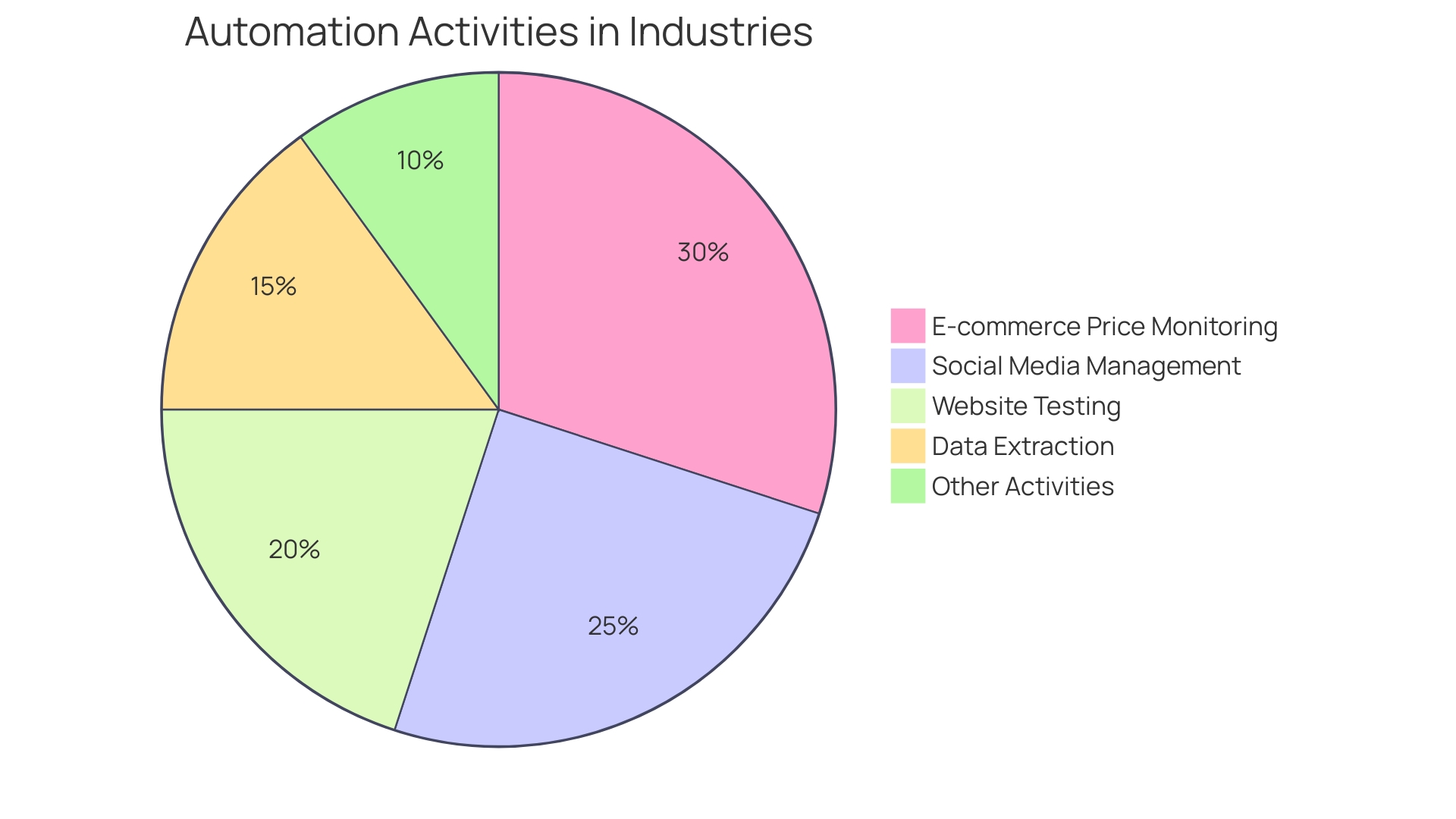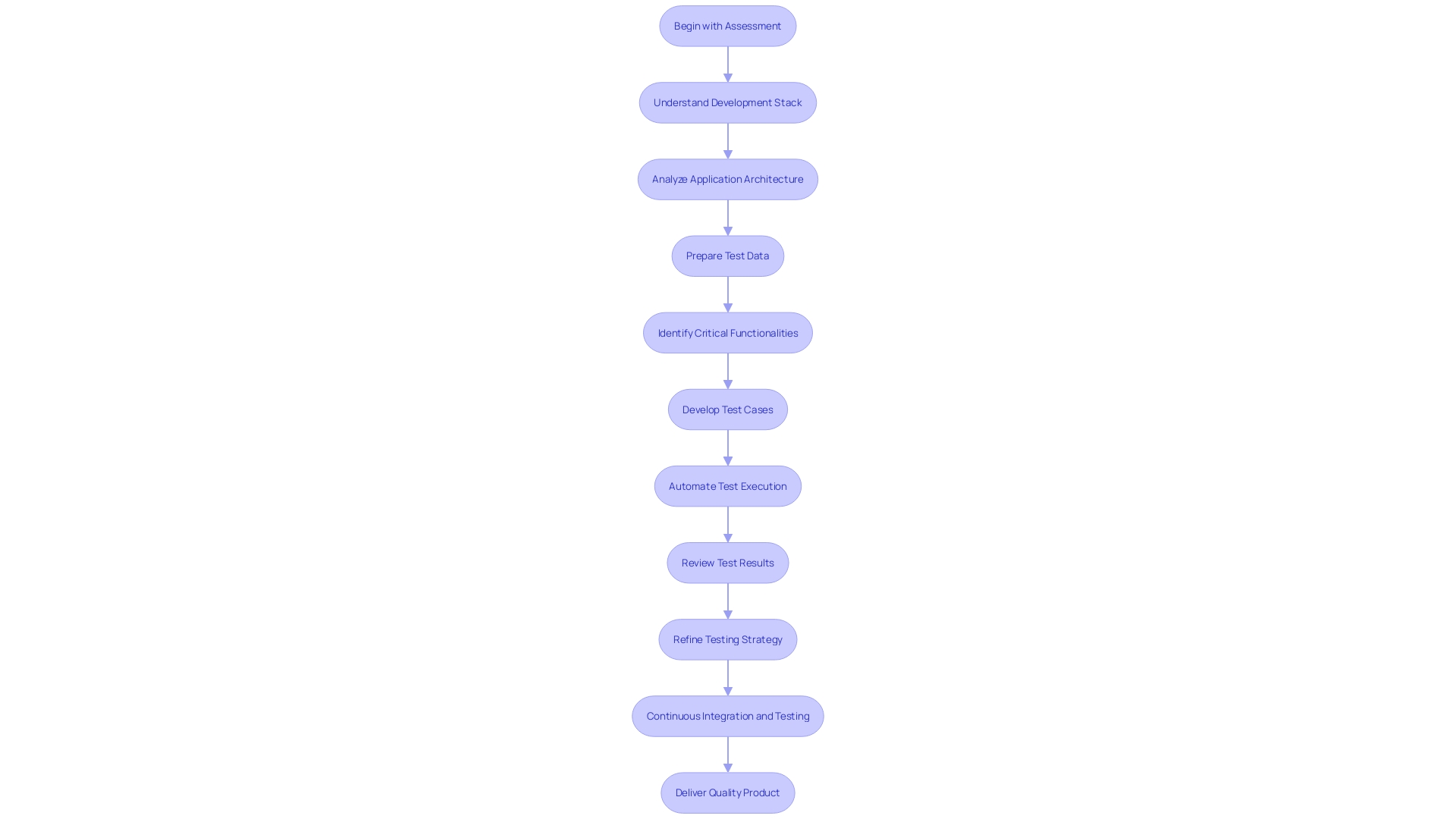Introduction
Web automation has emerged as a transformative force in today’s competitive business landscape, offering a range of benefits that go beyond saving time. From streamlining mundane tasks to enhancing operational efficiency, web automation is empowering businesses to achieve new levels of productivity. In this article, we will explore the benefits, tools, best practices, common use cases, and the process of selecting the right web automation tools.
We will also delve into designing and writing effective web automation test cases, as well as setting up environments and implementing parallelization techniques for efficient automation. Whether you are a developer or a non-technical user, this article will provide practical insights and solutions to help you leverage the power of web automation and drive operational excellence in your organization.
Benefits of Web Automation
Web technology stands as a transformative force for countless businesses, providing a vital edge in today’s competitive marketplace. At its essence, web streamlines a variety of online activities, surpassing the monotonous form fills to the intricacy of data extraction and content management systems. This digital leverage is not just about saving time; it’s about ensuring precision, reducing manual errors, and fostering a new level of operational efficiency. The scalable nature of technological advancements is particularly compelling, equipping businesses to manage and analyze vast data sets with unparalleled speed and agility.
The emerging functionalities of web robotic process encapsulate in Robotic Process RPA, a technological advancement that utilizes software bots to imitate or perform actions across various software or data systems, typically done by humans. These bots are adept at an array of functions from data entry and transaction processing to customer service interactions. The recent advancements in RPA have made a notable impact, facilitating the smooth integration of systems, freeing businesses from numerous tasks, and enabling the mechanization to bear the workload.
Observations from top companies demonstrate the significant impact of web mechanization. Specsavers, a pioneer in optometry, navigates a complex global supply chain and has innovated bespoke business processes and in-house technologies to surmount the challenges of integrating older medical devices into modern systems. Similarly, the finance sector has witnessed a proliferation of AI tools, with professionals seeking the best fit for enhancing their operations and customer experiences. Marketing has also seen a surge, with companies leveraging it to refine their financial services.
These advancements resonate with Tim Berners-Lee’s vision for the web, as we commemorate the 35th anniversary of its inception. His vision for a future where data flows effortlessly and artificial intelligence assistants have a deep understanding of our personal needs suggests the vast potential of web technology. This is further underscored by the recent surge in artificial intelligence, as highlighted in the notable scientific and technological advancements of 2023.
The integration of workflow mechanization is becoming more and more pervasive in contemporary enterprises, as a report by Zapier discloses that almost all employees in smaller businesses participate in repetitive assignments. The mechanization of such tasks is not just a convenience; it’s an essential strategy to reallocate valuable resources towards more strategic, value-added work. With the landscape of business continuously evolving, the strategic implementation of mechanization stands as an indispensable ally in the quest for operational excellence and sustainable growth.
Tools and Technologies for Web Automation
Web automation technologies have become indispensable in our rapidly digitizing world, with tools such as Selenium, Puppeteer, and BeautifulSoup at the forefront. They empower developers to automate interactions with web elements, simulate user actions, and harvest data from websites efficiently. Selenium, born from the visionary thinking of Jason Huggins at ThoughtWorks in 2004, has positioned itself as a versatile powerhouse, valuable not only for testing but also for automating a range of web-based administrative activities.
Beyond the realm of testing, the integration of Selenium with languages like Python has unlocked powerful opportunities for web scraping, a process that is becoming increasingly crucial for data analysis and machine learning endeavors. Moreover, the advent of Robotic Process Automation (RPA) technology has signaled a new era where bots emulate human actions, streamlining tasks such as data entry and transaction processing across diverse applications and platforms.
In the realm of software development, the significance of Quality Assurance (QA) cannot be emphasized enough, and mechanized instruments have become essential in guaranteeing software reliability. By automating test cases and validating outcomes, these tools, including JUnit for Java applications, mitigate human errors and enhance efficiency across multiple testing environments.
As we stand at the threshold of another year, full of technological advancements, it’s evident that the role of AI in web testing and testing will only grow more pronounced, reshaping workflows and introducing new paradigms in efficiency and effectiveness for developers and technologists alike.
Step-by-Step Guide to Building Automated Web Tasks
Developing efficient and sustainable solutions for web-based processes requires more than just coding; it’s about comprehending the complexities of each activity and designing a viable answer. To initiate this procedure, explore the manual implementation of activities to understand their intricacies, which can reveal the most recurring and mistake-prone operations ready for mechanization. Thorough documentation is crucial, documenting every element, from the instruments employed to the duration consumed, offering a plan for improving and advancing the workflow.
Once you’ve identified the monotonous tasks, you can utilize web tools to create scripts that interact with web interfaces, smoothly performing operations like form submissions or content updates. For example, utilizing powerful frameworks like. NET along with browser-managing libraries like Selenium, and incorporating AI features from platforms like OpenAI, enables advanced processes like summarizing email content.
As you develop these scripts, it’s crucial to put them through rigorous testing, refining their accuracy and reliability. Real-world case studies, like the creation of an automated podcast workflow, demonstrate the transformative impact of a well-oiled system, transforming creative aspirations into a streamlined, productive reality.
Scheduling or event-triggering these processes ensures they operate seamlessly within the set parameters, like the timely release of a podcast episode or updating website content. As the demand for mechanization expands, with an anticipated market rise to $264.69 billion by 2026, and with administrative tasks scheduled for a 69% mechanization rate by 2024, the quest for such technological progress is not just advantageous but necessary.
In the wide range of industries, from IT and finance to healthcare, the appropriate tools for streamlining processes can greatly enhance productivity, with engineering and IT overseeing a significant portion of an organization’s efforts to streamline operations. Whether it’s a no-code solution for non-technical users or a more complex system for developers, the end goal remains the same: a seamless user experience that delivers excellence in streamlining processes.
Best Practices for Web Automation
Web mechanization is a critical component in enhancing operational efficiency and delivering seamless services, much like the efforts of Surrey County Council in improving experiences for citizens and employees. To achieve this, developers must incorporate a structured approach, starting with planning and preparation. This entails clearly delineating the scope of mechanization, selecting cost-efficient and requirement-compatible tools, and establishing a strong framework to sustain mechanization endeavors.
Next, attention must be given to test case and data preparation. This entails configuring a test environment that accurately reflects the production setting and managing test data effectively. Moreover, security must be a priority, with vigilant authentication and access control measures to safeguard automated processes against the increasingly sophisticated tactics of bad bots, which now account for nearly a third of all web traffic.
To guarantee the durability and flexibility of scripts, they should be modular and reusable. This philosophy aligns with modern development practices, as evidenced by the technical stack selection for offering a consistent user experience that includes Django, Tailwind, and HTMX.
Monitoring and error handling are imperative to promptly identify and rectify any issues. This proactive stance is supported by data showing that a significant portion of attacks can be traced to their initial entry point, underscoring the importance of continuous vigilance.
Lastly, thorough documentation and knowledge sharing are indispensable for fostering team collaboration and effective troubleshooting. As the landscape of automation continues to evolve with advancements in IoT, AI, ML, and digitalization, staying informed through resources like Automation.com can provide valuable insights into current trends and best practices.
Common Use Cases for Web Automation
Automation technologies are transforming industries by carrying out a wide range of activities, including e-commerce price monitoring, social media management, data extraction, and website testing. For example, suppliers aiming to be competitive in online marketplaces like Home Depot utilize web scraping technologies, such as Helium Scraper, to monitor and adjust their product pricing based on real-time market data. This enables them to maintain a competitive edge by staying abreast of pricing trends and customer preferences.
In the realm of e-commerce, online sellers leverage tools like eBay scraper to track and analyze prices of similar products, allowing them to strategically adjust their pricing models. This approach not only enhances their competitiveness but also increases their profitability by responding swiftly to market demand fluctuations.
Moreover, the advancements in artificial intelligence have been recognized as a significant technological driver, with Collins Dictionary naming ‘AI’ as the word of the year for 2023. Ai’s capabilities in automating complex tasks are transforming industries, with its applications extending to automating devices and programming tasks.
In software development, careful planning and preparation are essential for an effective strategy. This involves defining the scope, selecting budget-friendly tools that meet specific requirements, and establishing a robust testing framework. Preparing accurate test data and configuring the environment to mirror production settings ensures the reliability and accuracy of automated tests.
The International Federation of Robotics reports a surge in manufacturing industrial robots, confirming the crucial role of technology in modern industries. Service sectors are also adopting automated processes, employing chatbots and virtual assistants to enhance customer interactions.
As we progress, the implementation of workflow streamlining is proving to be essential, with statistics indicating a significant increase in business dependence on streamlining post-pandemic. These trends emphasize the need for industries to evolve and adopt technology to maintain and enhance productivity and efficiency.

Selecting the Right Web Automation Tools
Choosing the perfect web solution relies on a thorough comprehension of your objectives and the particular requirements of your project. Start by analyzing the nature of your application, whether it’s a web, mobile, or desktop platform, and the operating systems it needs to support. This will assist you in determining the compatibility requirements of your automation software. Next, assess the skill set of your team; if they’re more adept with certain programming languages or development practices like BDD, choose a tool that aligns with these strengths.
Furthermore, contemplate the user profile and the complexities of the tasks at hand. A DevOps-focused platform might be necessary for some, while others could benefit from a more versatile solution. It’s also vital to consider who will be using the tool—developers or non-technical staff—as this will affect the ease of use and the level of code complexity (no, low, or high-code) required.
Due to the recent surge in the demand for mechanization, particularly after the pandemic, and industries such as IT, finance, healthcare, and manufacturing making significant investments in streamlining processes, the market is abundant with a range of solutions. The data shows that the businesses embracing workflow streamlining are moving forward, making it more crucial to select a solution that not only fulfills present requirements but is also adaptable for future growth.
To ensure you make an informed decision, delve into research, consider reviews, and seek expert opinions. Search for solutions that provide the versatility to reuse test steps across various scenarios, which can save valuable time and resources. Keep in mind, with the appropriate tool, you can greatly improve productivity and operational efficiency across different teams within your organization.

Designing and Writing Web Automation Test Cases
When venturing into the realm of automated web tasks, crafting robust test cases is paramount. The procedure commences with a thorough analysis of the application in question. This foundational step encompasses an examination of features, business rules, and the company’s wider product portfolio. On the technical front, understanding the development stack, architecture, and associated services is vital. With this comprehensive knowledge, one can tailor the automated tests to the nuances of the application, ensuring a more effective testing outcome.
To support the process of streamlining tasks, deploying a well-structured framework is essential. The framework should be designed from the ground up, possibly utilizing the capabilities of tools like Playwright for end-to-end testing. These tools not only enable the streamlining of test execution but also enhance it with capabilities like visual comparison, which is particularly useful in verifying UI elements.
Moreover, the preparation of test data is not to be underestimated. It involves meticulous creation, management, and organization to mirror the intricacies of production environments. This step is crucial for achieving test accuracy and reliability.
In the fast-paced world of 2024, where email outreach is a significant challenge for companies, the principles of testing technology resonate similarly. Automating processes like email contact acquisition can significantly cut down on time and resources, enabling businesses to concentrate on more strategic activities. This method has been demonstrated to save time, accumulate dependable data, and speed up operations, as observed in the frameworks developed for various industries.
Finally, it’s important to acknowledge that while ‘fully unit tested’ claims from vendors may provide a sense of security, the depth of testing can vary significantly. As revealed by industry experiences, thorough, comprehensive testing that includes various scenarios and edge cases is necessary to ensure quality and prevent the hard lessons learned from insufficient testing practices. The implementation of an end-to-end test framework is not just a technical task but a strategic move towards operational excellence and marketplace success.

Setting Up Environments and Parallelization for Web Automation
Efficient and scalable web operations are paramount, and achieving this starts with constructing a robust environment setup. It’s important to delineate separate environments for development, testing, and production to circumvent conflicts and guarantee stability. Markos Fragkakis, a Staff Engineer at Workable, underscores the significance of a meticulous setup, recounting how their Applicant Tracking System required a careful approach to manage its growth even as parts of it were segregated as other services.
In parallel, leveraging parallelization techniques is not just a matter of convenience but a necessity. Running multiple instances of scripts concurrently is a game-changer, enhancing performance while slashing execution times. This strategy aligns with industry trends, where a emphasis on mechanization enhances return on investment (ROI) by expanding test coverage exponentially. For instance, the Industrial Automation Services Market is poised for significant growth, expected to swell from $147.06 Billion in 2019 to $264.69 Billion by 2026.
Furthermore, the embrace of ephemeral environments, as delineated in ‘Introduction to Temporary Environments: A Beginner’s Guide’, showcases how automated setups with isolated, easily created and deleted environments are revolutionizing software testing. These contemporary solutions address the drawbacks of shared persistent environments by eliminating infrastructure overhead and queueing delays.
Automating as many tasks as possible is crucial, as highlighted by the statistic that 94% of companies engage in repetitive tasks. The emergence of mechanization and digitalization has enhanced jobs for 90% of knowledge workers, emphasizing the significance of embracing these strategies to uphold a competitive advantage in the fast-paced digital landscape.
In essence, properly segmenting environments and employing parallelization are not just best practices but are integral to the fabric of efficient web automation, shaping the future of the industry and the workforce within.
Conclusion
In conclusion, web automation is a transformative force that enhances operational efficiency and reduces manual errors. Robotic Process Automation (RPA) allows software bots to replicate or execute tasks traditionally performed by humans. Tools like Selenium, Puppeteer, and BeautifulSoup empower developers to automate interactions with web elements and harvest data efficiently.
Building effective automated web tasks involves understanding task intricacies, employing web automation tools, rigorous testing, and scheduling automations. Best practices like planning, test case preparation, security measures, and thorough documentation ensure seamless services and effective troubleshooting.
Web automation is widely used in various industries for tasks like e-commerce price monitoring, social media management, data extraction, and website testing. Selecting the right automation tools requires understanding project goals, application nature, team skills, and user profiles.
Designing and writing web automation test cases involve thorough analysis, deploying a well-structured framework, and meticulous test data preparation. Comprehensive testing ensures quality and prevents issues.
Setting up environments and leveraging parallelization techniques are crucial for efficient and scalable web automation. Properly segmenting environments and automating tasks contribute to operational excellence.
In summary, web automation empowers businesses to achieve operational excellence and drive productivity. By embracing the benefits, selecting the right tools, following best practices, and designing effective test cases, organizations can harness the full potential of web automation in today’s competitive business landscape.

